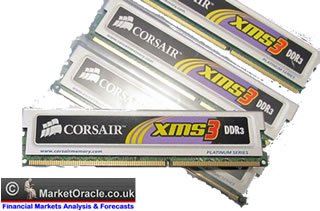Top Six ETFs Active Investors Should Know
Stock-Markets / Exchange Traded Funds Aug 13, 2009 - 07:41 AM GMT Ron Rowland writes: Every week in my Money and Markets column, I try to show you how to boost your portfolio by using exchange-traded funds (ETFs). Today I’m giving you an assignment: Know your ETFs.
Ron Rowland writes: Every week in my Money and Markets column, I try to show you how to boost your portfolio by using exchange-traded funds (ETFs). Today I’m giving you an assignment: Know your ETFs.
Specifically, I want you to get familiar with six of the most popular ETFs that track key stock market benchmarks. You need to know their ticker symbols by heart … they’re the bread and butter in your ETF shopping cart.
These six ETFs are large and actively traded; in fact, even with more than 800 other ETFs available it’s not unusual for this small group to account for almost half the value of all ETF trading in the U.S.
Now I’m NOT saying you should buy any of my bread and butter ETFs right now. My point is that if you want to be a successful investor, it’s a big help to know what’s available. If you do, you’ll be able to react more quickly when the time is right.
Ready to get started? Here we go.
Bread and Butter ETF #1: SPY
SPDR Trust is the granddaddy of all ETFs. Introduced in 1993, the SPY (that’s the ticker symbol) was the very first U.S.-listed ETF and tracks the S&P 500. This index of 500 large-capitalization stocks is a standard benchmark for the U.S. equity market.
When you buy shares of SPY, you get an instant portfolio of 500 domestic stocks covering every industry sector. Financials, technology, health care, energy … they’re all in there!
No wonder, then, that when big investors want to get instant, diversified market exposure, they often turn to the SPY. But you don’t have to be a millionaire; you can buy SPY shares even if you only have a few hundred dollars.
Bread and Butter ETF #2: QQQQ
PowerShares QQQ used to be called the “Nasdaq 100 Tracking Stock” until the Nasdaq honchos decided to spin off their ETF business to PowerShares.
This can be confusing, so read closely: The name of the ETF is PowerShares QQQ, with three Q’s. The ticker symbol is QQQQ. That’s four Q’s. Clear enough? Obviously someone wants to keep us all on our toes.
In any case, the QQQQ is based on the Nasdaq 100 Index. Note that this is not the same as the Nasdaq Composite Index that you typically see quoted in the news media. The Nasdaq 100 is a sub-set of the Composite, consisting of the 100 largest non-financial stocks in the index.
Back in the 1990s, the Nasdaq was home to many small technology companies — a few of which grew much bigger. That legacy survives in the Nasdaq 100, which is heavily tilted toward technology stocks. In fact, many traders look at it as nothing more than a large-cap tech benchmark.
 |
| QQQQ is heavy on technology stocks. |
If you want exposure to banks, real estate or insurance stocks, don’t bother with the QQQQ. You won’t find them there. Nor will you find the blue-chip companies that call the New York Stock Exchange their home. But if you’re after a highly liquid, volatile trading vehicle, the QQQQ is hard to beat.
Bread and Butter ETF #3: DIA
The DIAMONDS Trust follows the Dow Jones Industrial Average, which is probably the best-known stock market proxy in the world.
Unfortunately, the Dow is also mostly useless as a benchmark, at least in my opinion, and so are products like the DIA that attempt to follow the Dow.
I’ve used the DIA from time to time since it came out in 1999, but it has three big problems …
First, like the Dow, it’s very narrow with only thirty stocks. That simply isn’t enough to reliably represent the U.S. industrial economy, as the Dow purports to do.
Second, the DIA excludes some key sectors like transportation and utilities. Dow Jones publishes separate indexes for those groups.
Third, the Dow and the DIA are weighted by the share price of the component stocks rather than the market value. This was advantageous back in the days when you had to calculate things on the back of an envelope, but now it’s just outmoded.
Despite these issues, there are times when the DIA can come in handy. For instance, if you’re looking for an actively-traded proxy of mega-cap stocks, the DIA might be a good pick.
Bread and Butter ETF #4: IWM
The IWM is the iShares Russell 2000 Index Fund. What’s the Russell 2000? You already know the answer if you’re a fan of small-cap stocks.
Each year, Frank Russell Associates ranks all the stocks in the U.S. by their market value. Chop off the top 1,000 biggest stocks and consider the next 2,000. That’s the Russell 2000.
 |
| IWM captures the small fry stocks. |
These are relatively small companies — but that’s the whole point! When the U.S. economy is booming, small-cap stocks usually lead the way higher. And the IWM lets you buy hundreds of tiny stocks in one simple trade.
The IWM should be a staple item for almost every investor. It’s easy to jump in and out as the economy fluctuates, and you get plenty of diversification. There’s no better way to play the domestic, small-cap stock market.
Bread and Butter ETF #5: EFA
The iShares MSCI EAFE Index Fund is international because it’s based on the Europe, Australasia and Far East Index published by Morgan Stanley Capital International.
I know that’s quite a mouthful. Let me break it down for you: The EAFE Index is designed to represent the entire developed world, excluding the U.S. and Canada. It includes Western Europe, Australia, Japan — the countries with modern stock markets and banking systems (in contrast to the emerging markets, which we’ll get to in a minute).
 |
| France is part of the EFA portfolio. |
The list of countries in the index can change. Recently MSCI promoted South Korea and Israel to developed-market status, and stocks from those countries were added to the index and to the EFA.
The EFA is useful as a way to round-out a portfolio that already includes enough U.S. stocks. Say you own the SPY and the IWM, but you want to have exposure to the rest of the world. Add the EFA to the mix and you’re almost there.
I say almost because there’s one final piece …
Bread and Butter ETF #6: EEM
The EEM is the standard ETF if you want to trade emerging markets. These are places that only recently established economic ties with the rest of the world and are growing quickly. Markets like Brazil, Russia, India and China are good examples.
MSCI produces an Emerging Markets Index as a benchmark for these markets, and the EEM lets you trade that index. This is a really handy fund because it’s often difficult and expensive to buy individual stocks in emerging markets.
The EEM is a quick and easy way to allocate some of your portfolio to emerging markets. Keep it on the tip of your tongue for the next time you’re ready to make such a move.
Express Check-Out For Active Investors
There you have them: SPY, QQQQ, DIA, IWM, EFA and EEM. These are the six ETFs every investor ought to know. Get familiar with them. Add them to your watch list, and be aware of how they could fit into your portfolio.
Best wishes,
Ron
P.S. I’m now on Twitter. Please follow me at http://www.twitter.com/ron_rowland for frequent updates, personal insights and observations about the world of ETFs.
If you don’t have a Twitter account, sign up today at http://www.twitter.com/signup and then click on the ‘Follow’ button from http://www.twitter.com/ron_rowland to receive updates on either your cell phone or Twitter page.
This investment news is brought to you by Money and Markets . Money and Markets is a free daily investment newsletter from Martin D. Weiss and Weiss Research analysts offering the latest investing news and financial insights for the stock market, including tips and advice on investing in gold, energy and oil. Dr. Weiss is a leader in the fields of investing, interest rates, financial safety and economic forecasting. To view archives or subscribe, visit http://www.moneyandmarkets.com .
Money and Markets Archive |
© 2005-2022 http://www.MarketOracle.co.uk - The Market Oracle is a FREE Daily Financial Markets Analysis & Forecasting online publication.



